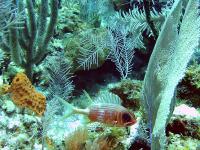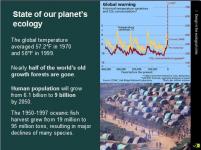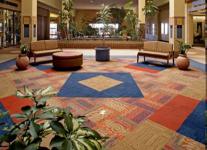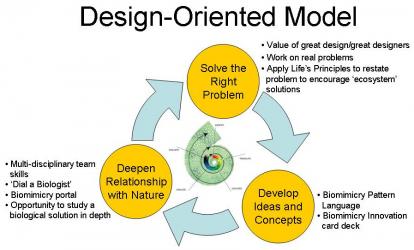CE 2006 Biomimicry Workshop (Norbert Hoeller)
 The Canadian Federation of Engineering Students organizes yearly Complementary Education courses that "offer an intimate, focused learning opportunity for engineering students to extend their education beyond the material taught at school". The University of Toronto was chosen to host the course in 2006 on the theme "BioDesign: Breathing Life into Technology". I was invited to do full-day workshop on biomimicry to a group of 25 engineering students from universities across Canada as well as the University of Michigan. The students were in their first to fourth year of study and represented a wide range of disciplines including Nanotechnology, Systems Design and Biological Engineering.
The Canadian Federation of Engineering Students organizes yearly Complementary Education courses that "offer an intimate, focused learning opportunity for engineering students to extend their education beyond the material taught at school". The University of Toronto was chosen to host the course in 2006 on the theme "BioDesign: Breathing Life into Technology". I was invited to do full-day workshop on biomimicry to a group of 25 engineering students from universities across Canada as well as the University of Michigan. The students were in their first to fourth year of study and represented a wide range of disciplines including Nanotechnology, Systems Design and Biological Engineering.
 Given the audience, the workshop focused less on inspiration and more on practical concepts that the participants could apply immediately. The goal was to encourage a balanced yet hopeful view, using nature as a source of tangible models that are vibrant, diverse, effective and enduring. A key objective was building confidence that the participants could be better designers through practice in using selecting bio-inspired tools.
Given the audience, the workshop focused less on inspiration and more on practical concepts that the participants could apply immediately. The goal was to encourage a balanced yet hopeful view, using nature as a source of tangible models that are vibrant, diverse, effective and enduring. A key objective was building confidence that the participants could be better designers through practice in using selecting bio-inspired tools.
The Importance of Design
 The first part of the workshop introduced the importance of design by asking the participants to suggest 'watershed' moments in history. These are often associated with periods of both challenges and opportunities where key events allowed individuals to make a significant and long-lasting difference. We live at such a watershed period today as we face the challenges of climate change, unsustainable resource extraction, pollution, poverty and ill health. The Ray Anderson clip from the CBC program Biomimicry - Learning from Nature showed the negative impacts of human progress but raised a note of optimism: we have only recently started to 'turn the clock back'. We behave like Type I species that are opportunistic, fast growing and profligate in resource usage but are not long-lasting. Yet in spite of the challenges, we are living at a time when awareness is growing, mobilizing people is becoming easier, and new approaches to analysis, design and implementation are beginning to appear. Designers have the potential of making 'watershed' impacts through their influence on the products and services we use every day.
The first part of the workshop introduced the importance of design by asking the participants to suggest 'watershed' moments in history. These are often associated with periods of both challenges and opportunities where key events allowed individuals to make a significant and long-lasting difference. We live at such a watershed period today as we face the challenges of climate change, unsustainable resource extraction, pollution, poverty and ill health. The Ray Anderson clip from the CBC program Biomimicry - Learning from Nature showed the negative impacts of human progress but raised a note of optimism: we have only recently started to 'turn the clock back'. We behave like Type I species that are opportunistic, fast growing and profligate in resource usage but are not long-lasting. Yet in spite of the challenges, we are living at a time when awareness is growing, mobilizing people is becoming easier, and new approaches to analysis, design and implementation are beginning to appear. Designers have the potential of making 'watershed' impacts through their influence on the products and services we use every day.
The first exercise looked at the role of design in three areas from the perspective of the workshop participants:
- What are the key success factors? The participants listed reduced cost, efficiency, environmental safety, versatility and solving root causes of problems were high on the list
- What are some of the key innovations in their field? Brain/computer interfaces, inter-disciplinary research and nanotechnology each got more than one vote.
- What are the key contributors to innovation? Communication/collaboration/teamwork, research current/past solutions, brainstorming led the list, with 'ideas from other disciplines' at the bottom.
 A clip from William McDonough's presentation at Bioneers 2000 introduced the concept of 'intentional design' which takes into account the value of all species for all times, establishing an enduring legacy and "becoming native to this place". Janine Benyus described the concepts of biomimicry through another clip from Biomimicry - Learning from Nature and introduced Wes Jackson's study of the tallgrass prairie that our pioneers plowed under, because “We didn’t see this place for what it was, so much as for what it could become.” The two clips illustrated the contrast between the scientist who is "studying what has been to understand it [and the designer who] is studying what might be to create it" (Ted Rosen). Biomimicry helps bridges the two domains by showing how our understanding of natural systems can profoundly influence our designs. However, making use of that knowledge will require designers to enhance their skills in observation, pattern recognition, integration, collaboration, leadership and communication.
A clip from William McDonough's presentation at Bioneers 2000 introduced the concept of 'intentional design' which takes into account the value of all species for all times, establishing an enduring legacy and "becoming native to this place". Janine Benyus described the concepts of biomimicry through another clip from Biomimicry - Learning from Nature and introduced Wes Jackson's study of the tallgrass prairie that our pioneers plowed under, because “We didn’t see this place for what it was, so much as for what it could become.” The two clips illustrated the contrast between the scientist who is "studying what has been to understand it [and the designer who] is studying what might be to create it" (Ted Rosen). Biomimicry helps bridges the two domains by showing how our understanding of natural systems can profoundly influence our designs. However, making use of that knowledge will require designers to enhance their skills in observation, pattern recognition, integration, collaboration, leadership and communication.
Ask the Right Questions
 Give designers and problem and they will find a solution. Problem statements necessarily constrain the possible solutions, both in their explicit wording and the assumptions made by the designer. According to David Oakey, the carpet industry had become obsessed with uniformity in color in an attempt to make carpet seams invisible. He decided to re-state the problem to incorporate concepts of diversity. As described in the December 2005 Newsletter (pages 7-9), the resulting Entropy carpet tile delivered on the requirement of reducing waste in production and installation while allowing customers to easily replace carpet tiles even years after the original installation.
Give designers and problem and they will find a solution. Problem statements necessarily constrain the possible solutions, both in their explicit wording and the assumptions made by the designer. According to David Oakey, the carpet industry had become obsessed with uniformity in color in an attempt to make carpet seams invisible. He decided to re-state the problem to incorporate concepts of diversity. As described in the December 2005 Newsletter (pages 7-9), the resulting Entropy carpet tile delivered on the requirement of reducing waste in production and installation while allowing customers to easily replace carpet tiles even years after the original installation.
This section of the workshop introduced Life Cycle Assessment and Global Footprint Analysis to help participants understand how products and services fit into the larger system by assessing their environment impacts from extraction to disposal. The Natural Step's Four Systems Conditions were discussed as a qualitative way of evaluating processes and organizations in terms of how well they "maintain the essential natural resources, structures and functions that sustain human society". McDonough in Cradle to Cradle showed how we can eliminate toxic substances from products.
At Bioneers, McDonough also emphasized the importance of effective buildings that meet the needs of the occupants, rather than efficient buildings that limit access to natural light and ventilation. How can we create designs that are sustaining, rather than being 'sustainable'? Rather than having a negative influence on the earth, could we become 'ecosystem engineers' that make a positive contribution to the biosphere? What can we learn from dynamic yet resilient natural systems? The Life's Principles are one way to tap into this knowledge and they were positioned in this workshop as a means of finding alternative ways of stating a problem, on the assumption that a good problem statement is more likely to lead to good solutions.
The students were presented with a list of Life's Principles adapted from Janine's Biomimicry: Innovation Inspired by Nature. After a brief discussion of what each principle meant, the students were asked to provide a counter-example as well as biological or technical examples that were compatible with the Life's Principles. The results were merged into a spreadsheet that the students could use during an exercise where the challenge was not to solve a problem but to restate the problem in a way that might lead to novel and useful solutions. Four teams were given 20 minutes to review each of the Life's Principles and determine if it suggested ways of seeing the problem in a new light.
Three of the teams were able to bridge from the Life's Principles to novel re-statements of the problem, with two linking to specific Life's Principles.
| Original Problem | Life's Principles | Revised Problem |
| How can we reduce CO2 emissions? |
Conserves value, Interconnected, Builds new capabilities, Enhances the biosphere |
How can we harness CO2 emissions for the betterment of the planet? |
| Handle a higher volume of traffic | How do we redesign the transportation system itself? How do we anticipate traffic behavior and have the system adapt to handle it better? How do we provide information and feedback to drivers? How do we shift the responsibility on the companies that the traffic is traveling to? | |
| How can we eliminate excess heat produced by laptops? | Conserves value | How can we use the excess heat (power speakers, webcam, etc.)? Can we use materials with higher heat capacities? |
| Build to shape | How can we better organize the location of heat emissions? | |
| Interconnected | What accessories can we design or redesign (i.e. desks, docking stations, cases)? |
Bio-Inspired Design
The third section of the workshop introduced the concept of bio-inspired design using a clip from Dayna Baumeister's 2005 presentation at the Ontario College of Art and Design as well as case studies such as the Lotus Effect, Velcro, the PAX Streamlining Principle and the Bionic Concept Car. The participants were introduced to Christopher Alexander's Pattern Language as a potential hybrid of the "Biology to Design" and "Design to Biology" approaches. Using a preliminary list produced by the Patterns from Nature project, participants identified natural as well as technical examples and counter-examples. The four teams applied the patterns to the problems used in the previous exercise to develop innovative solutions. Three teams were able to articulate the specific patterns that they employed.
| Original Problem | Pattern | Possible Solutions |
| Handle a higher volume of traffic | Stable growth | Better interface between different types of transportation |
| Closed loop | Make use of underused paths. | |
| Resilience, Feedback | Dynamically optimize traffic flow based on usage information | |
| Redundancy, Diversity | Increase transportation options. | |
| Effective vs. Efficient | More forethought in road design and planning. | |
| Built-in buffers | Optimized road size throttling | |
| Hierarchical systems | Promotion of public transit options also reduces pollution. | |
| Embedded information | In-vehicle GPS/real time traffic information | |
| Do more with less | Optimal use of vehicle capacity. | |
| How can we eliminate excess heat produced by laptops? | Closed loop | Harness excess energy to charge battery |
| Feedback/Distributed system | Switching to different CPUs depending on the level of usage (slower CPU = less heat produced) | |
| Adaptation/Distributed system | Not using the hard drive when one is a part of a network; use a central server that distributes info to all users | |
| Smart materials | Design a product (laptop case?) that can directly absorb excess heat. | |
| Symbiosis | Redirect the excess heat into a useful energy source (coffee maker) | |
| How can we develop a more efficient household refrigerator? | Something from Nothing | Recycle waste from one system to run another (use coils to pre-heat water)* |
| Adaptation | Only cool certain part of the fridge (small compartments with individual doors) | |
| Closed loop | Use external temperature (adaptive) | |
| Resilience | Control temperature through a timer to adapt to needs | |
| Materials | Better insulators |
* The December 2011 issue of the Canadian Consulting Engineer (12MB PDF, page 15-16) describes how waste heat from freezers and refrigerators (amongst other equipment) is captured via a water-to-water heat pump system that feeds a closed-loop space heating system.
Deepen Relationship with Nature
 The last section explored the biomimicry Mentor/Model/Measure process as well as a variant that pulled together the key concepts from the workshop:
The last section explored the biomimicry Mentor/Model/Measure process as well as a variant that pulled together the key concepts from the workshop:
- Solve the right problem by using the Life's Principles and striving for 'ecosystem' solutions
- Develop ideas and concepts using the Design Spiral, the biomimicry portal and the proposed biomimicry Pattern Language
- Deepen the relationship with Nature by involvement in multi-disciplinary teams, the biomimicry portal and seeking opportunities to explore a biological solution in depth
The workshop wrapped up with a final clip of McDonough describing the development of a truly safe textile. About 8,000 chemicals were evaluated against a wide range of ecological criteria that eliminated all but 38. In addition to developing a fabric that is truly benign, the process to produce this fabric eliminated all of the toxic waste normally associated with textile mills. When inspectors came to test the outflow from the mill, they thought their instruments had failed because the water leaving the plant was as clean or even cleaner that the water entering. The need for inspections and regulation can be effectively eliminated through a closed-loop process developed using 'intentional design'. "May you live in interesting times!"
A PDF of the presentation, the Life's Principles spreadsheet and the Patterns spreadsheet can be downloaded below by registered users.
Image Credits:
- Networked world: © ktsdesign - Fotolia.com
- underwater scene: Norbert Hoeller (Little Cayman, 2006)
- State of our planet's ecology: Okala Ecodesign Guide (2005 curriculum)
- Buffalo herd: © Jim Parkin - Fotolia.com
- Pictorials carpet tile (lounge are): InterfaceFlor
- Design Oriented Model: Norbert Hoeller
